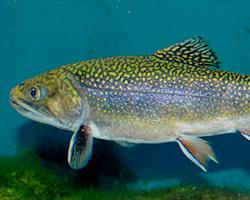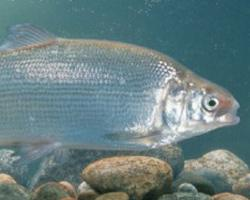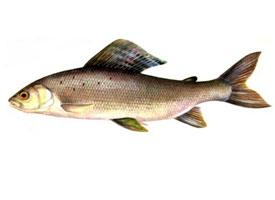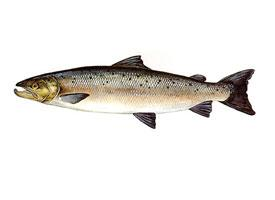
Váhy a míry
| Délka | od 70 do 150 cm |
|---|---|
| Hmotnost | od 8 do 13 kg |
Popis zvířete
The Atlantic salmon (Salmo salar) is a remarkable species of fish that holds a significant place in the world's rivers and oceans, as well as in human culture and economy. Known for its incredible lifecycle and migrations, this species is a true marvel of the aquatic world, embodying both resilience and vulnerability.Physical Characteristics:
The Atlantic salmon is a sleek and powerful fish, easily recognized by its silvery-blue body that glistens in the water. Adults can vary greatly in size, depending on their age and the conditions of their habitat, typically ranging from 28 to 30 inches in length and weighing between 8 to 12 pounds, though specimens exceeding 30 pounds are not uncommon. They possess a distinctive physical feature known as parr marks—dark vertical bars along their sides—that are especially prominent during their juvenile freshwater phase. As they mature and transition to the marine phase of their life, their coloration shifts to a more uniform silvery hue, which helps camouflage them in the open ocean.
Lifecycle and Migration:
The lifecycle of the Atlantic salmon is a fascinating journey that spans both freshwater and marine environments. They begin their lives in the cool, clear streams of their natal rivers, where eggs are laid in gravel nests called redds. After hatching, the young salmon, known as parr, spend one to three years growing in their freshwater habitat. Once they undergo a physiological transformation known as smoltification, which prepares them for life in saltwater, they migrate to the ocean, marking the beginning of their marine phase.
The marine phase of the Atlantic salmon's life is spent in the cold, nutrient-rich waters of the North Atlantic Ocean, where they can cover thousands of miles in search of feeding grounds. This period can last from one to three years, during which they grow significantly, accumulating fat reserves for their return journey to freshwater.
In an extraordinary display of endurance and navigation, mature Atlantic salmon then migrate back to their natal rivers to spawn, often overcoming significant obstacles such as waterfalls and fish ladders. Remarkably, they cease feeding upon entering freshwater, relying entirely on stored body reserves to fuel their journey. After spawning, a process which can be exhaustive and lethal for many, some individuals, known as kelts, manage to survive and return to the ocean, potentially to repeat the migration and spawning cycle.
Conservation Status:
The Atlantic salmon has faced significant declines in many of its native habitats due to a combination of overfishing, habitat loss, pollution, and climate change. These factors have led to its listing as an endangered species in some regions, prompting a variety of conservation efforts aimed at restoring its populations and habitats. These efforts include habitat restoration, the creation of fish passages around obstacles, and strict regulations on fishing practices.
Cultural and Economic Importance:
Beyond its ecological role, the Atlantic salmon holds considerable cultural and economic significance. It has been a staple food source for indigenous and local communities across the North Atlantic region for thousands of years. In modern times, Atlantic salmon is a highly prized species in commercial fisheries and aquaculture, contributing significantly to the global seafood market. However, the farming of Atlantic salmon in open-net pens has raised environmental concerns, including the spread of diseases to wild populations and the impact of escaped farmed salmon on wild gene pools.
In conclusion, the Atlantic salmon is an extraordinary fish that captures the imagination with its beauty, strength, and remarkable migratory journey. Its story is one of resilience against the backdrop of environmental changes and human impacts, highlighting the need for continued conservation efforts to ensure the survival of this iconic species for future generations.
Mapa výskytu
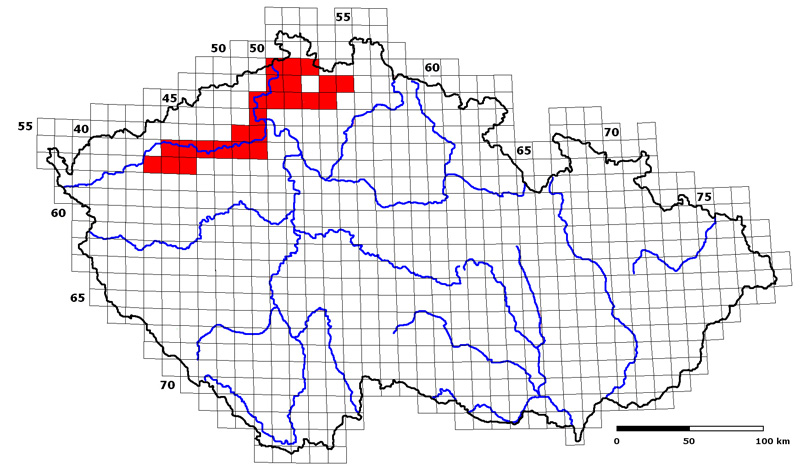
Podobná zvířata
Nové fotografie zvířat
Top 10 zvířat
- Chinese water dragon (Physignathus cocincinus)
- Galápagos tortoise (Geochelone nigra complex)
- Dolphin gull (Leucophaeus scoresbii)
- Japanese macaque (Macaca fuscata)
- Colombian red howler (Alouatta seniculus)
- Sea urchins (Echinoidea)
- Moustached guenon (Cercopithecus cephus)
- Diana monkey (Cercopithecus diana)
- Common reed warbler (Acrocephalus scirpaceus)
- Common house mosquito (Culex pipiens)
